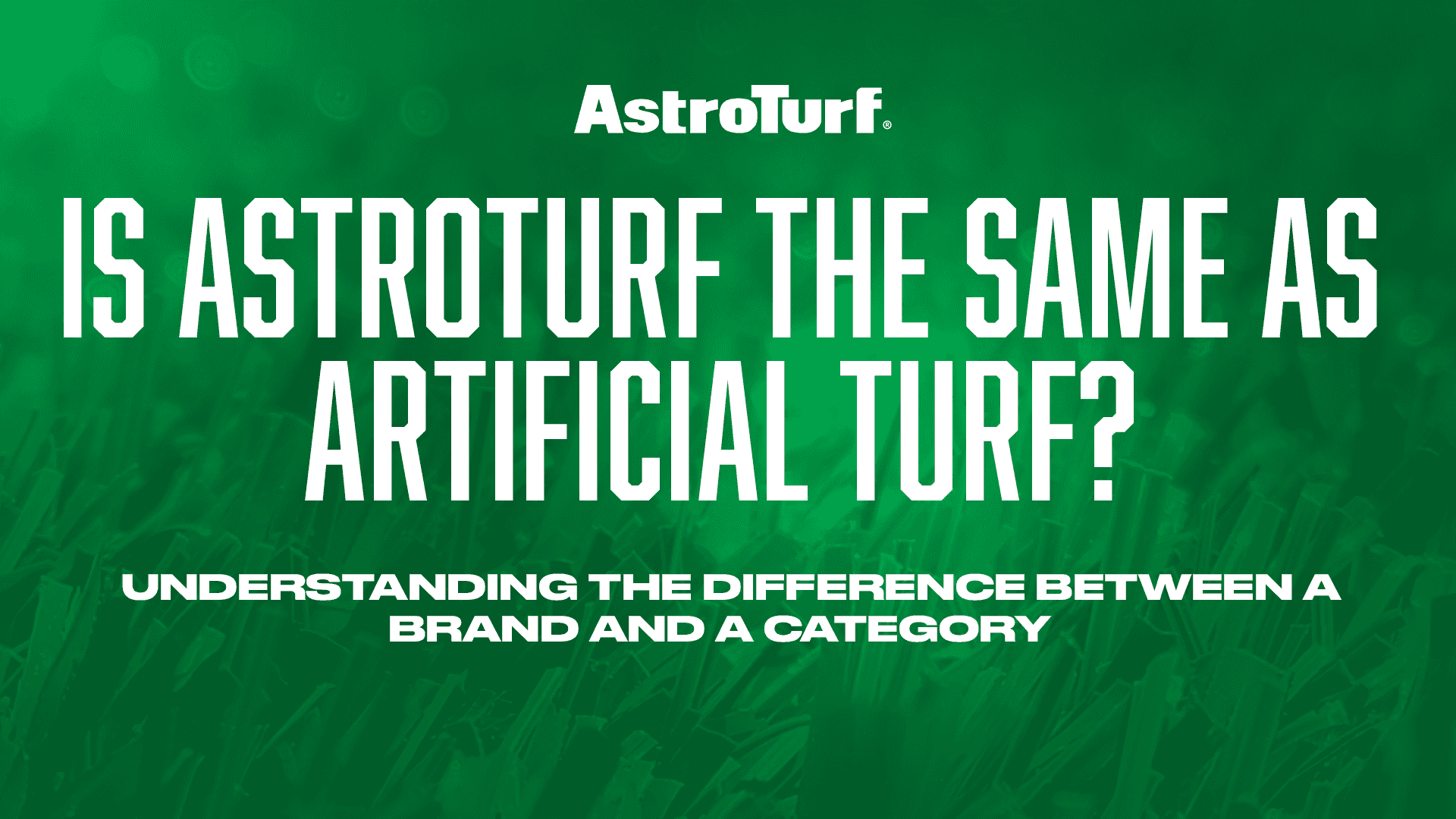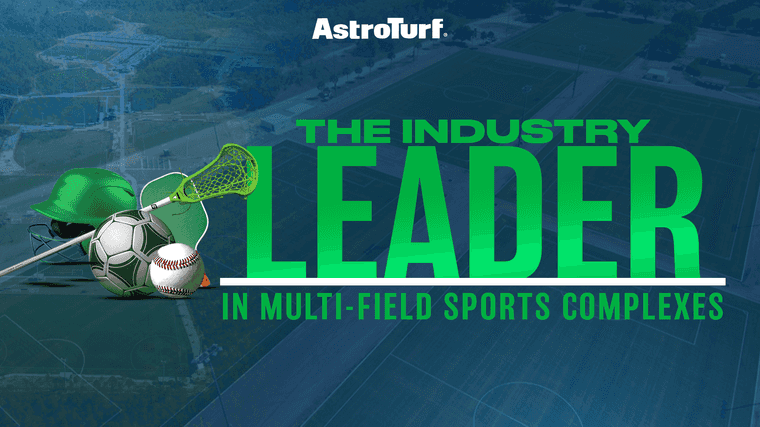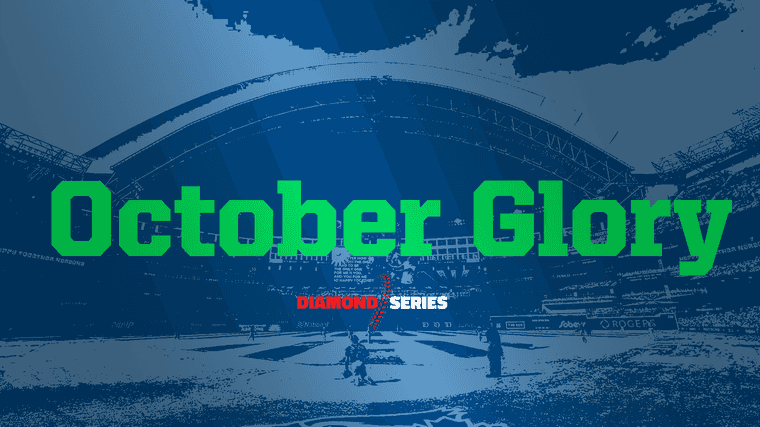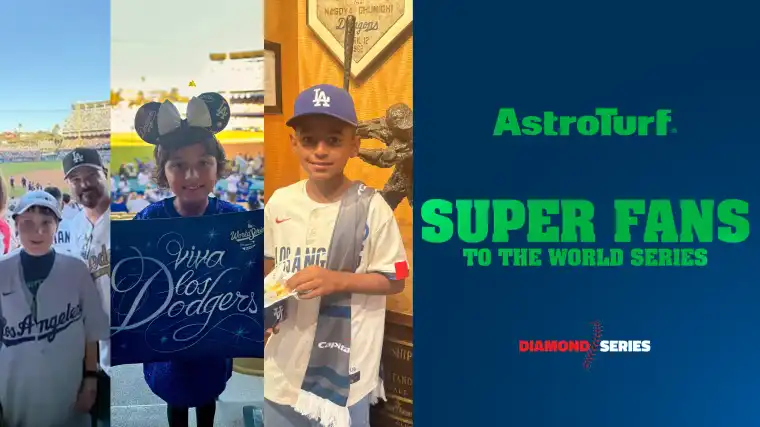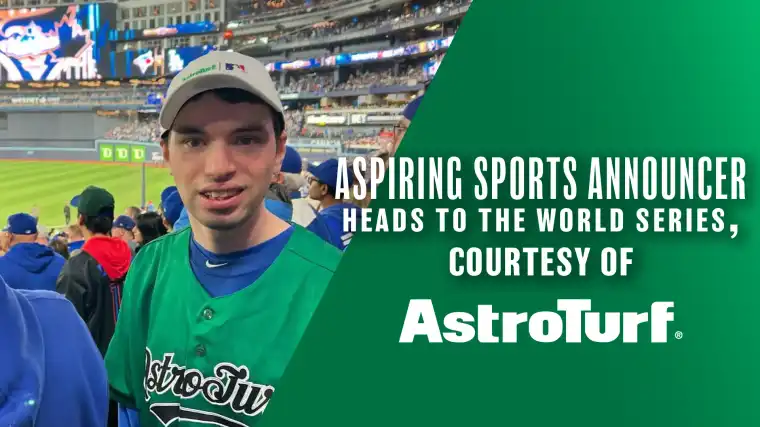One of the most common questions we receive at AstroTurf is whether our product is the same as artificial turf. The short answer is both yes and no, depending on context. While AstroTurf is a type of artificial turf, not all artificial turf is AstroTurf. This distinction matters more than you might think, especially if you’re investing in a synthetic surface for your facility, school, or home.
Direct Answer: AstroTurf is a specific brand of artificial turf with proprietary technologies and performance characteristics. “Artificial turf” is the generic term for all synthetic grass products, regardless of manufacturer. The relationship is similar to how Kleenex is a brand of facial tissue, or how Band-Aid is a brand of adhesive bandage.
Understanding this distinction helps you make informed decisions about sports surfaces, landscaping projects, and facility investments. Let me explain the differences, what makes our products unique, and why the distinction matters.
What Is Artificial Turf?
Artificial turf is the broad category term for any synthetic surface designed to replicate natural grass. The global artificial turf market includes dozens of manufacturers producing surfaces for sports fields, residential lawns, commercial landscaping, and recreational facilities.
All artificial turf systems share certain basic characteristics:
- Synthetic fibers: Made from polyethylene, polypropylene, nylon, or blended materials that replicate grass blades
- Backing system: The foundation that holds fibers in place and provides structural integrity
- Infill material: Granular substances placed between fibers to provide cushioning, stability, and realistic playing characteristics
- Drainage system: Perforations or channels that allow water to pass through the surface
However, the quality, performance, durability, and safety characteristics of artificial turf vary dramatically between manufacturers. Not all synthetic surfaces perform equally, which is why the specific brand and technology matter significantly.
What Makes AstroTurf Different?
We are a specific manufacturer with proprietary technologies developed through decades of research and innovation. Our products incorporate features that distinguish them from generic artificial turf:
RootZone Technology
Our RootZone system represents one of the most significant innovations in synthetic turf design. This technology uses crimped nylon fibers that create a three-dimensional matrix beneath the playing surface, effectively encapsulating infill material. This design prevents infill migration, maintains consistent surface characteristics throughout the field’s lifespan, and reduces the amount of infill that leaves the playing area on equipment or clothing.
Independent research from Michigan State University identified RootZone technology as producing biomechanical characteristics that closely replicate natural grass, contributing to player safety by maintaining uniform shock absorption across the entire surface.
Trionic Plus Fiber Technology
Our Trionic Plus system combines co-polymers of nylon and polyethylene, creating fibers that balance durability with the softer feel athletes prefer. This hybrid approach includes several integrated technologies:
- Sharkskin technology: Reduces skin friction by up to 30% compared to standard polyethylene fibers, addressing abrasion concerns
- Statblock antistatic additive: Inhibits static electricity by up to 17 times, helping maintain infill stability
- DualChill thermal shield: Provides 42% improvement in infrared reflectivity, reducing surface temperatures in hot conditions
- Sanitized antimicrobial protection: Eliminates bacterial odors and prevents microbial buildup on fiber surfaces
Sport-Specific Engineering
We develop specialized systems for different sports applications rather than offering one-size-fits-all products. Our Diamond Series for baseball features zone-specific engineering with different fiber types and pile heights for base paths versus outfield areas. Our Poligras systems for field hockey meet International Hockey Federation standards while incorporating sustainable materials.
This sport-specific approach emerged from our twelve-year partnership with the University of Tennessee’s Department of Turf Sciences, where academic research validates product innovations before market introduction.
The History Behind the Name Confusion
The confusion between AstroTurf as a brand and artificial turf as a category stems from our historical role in creating the synthetic turf industry. When we installed the first synthetic playing surface in the Houston Astrodome in 1966, we weren’t just introducing a product; we were creating an entirely new category.
The first Major League Baseball game on synthetic turf occurred on March 21, 1966, when the Houston Astros hosted the Los Angeles Dodgers on our surface. The installation attracted massive media attention, with television broadcasts introducing millions of Americans to synthetic playing surfaces for the first time.
Because we were the only manufacturer with widespread visibility during this crucial period, people began using “AstroTurf” as shorthand for all synthetic surfaces. This phenomenon continued through the 1980s when ten of twenty-six Major League Baseball teams played on artificial turf. Even when other manufacturers entered the market, many people mistakenly continued using “AstroTurf” to describe any synthetic surface.
Performance Differences Between AstroTurf and Generic Artificial Turf
The distinction between our products and generic artificial turf becomes clearest when examining performance metrics and testing standards.
Testing and Certification
We subject all our systems to rigorous internal and external testing before field deployment. Our testing protocols exceed industry minimums and include:
- Berlin Athletes machine testing: Measures shock absorption, vertical deformation, and energy restitution
- One Turf testing: Aligned with FIFA, World Rugby, and FIH standards, considered the gold standard in synthetic turf evaluation
- Accelerated wear testing: Simulates years of use within compressed timeframes to validate durability claims
- Environmental testing: Includes UV exposure, temperature cycling, and chemical resistance assessment
Many artificial turf manufacturers use less comprehensive testing, focusing primarily on basic safety thresholds like GMax (maximum impact force) without evaluating the full range of performance characteristics that affect player experience and long-term durability.
Manufacturing Quality Control
We control all aspects of manufacturing from initial masterbatch formulation through final field installation. This vertical integration ensures quality control at every stage and allows us to guarantee that only approved formulations and materials appear in finished products.
This matters particularly given recent concerns about chemical additives in synthetic materials. All AstroTurf products currently manufactured are PFAS-free, and we specify that all turf ingredients be free of these substances when purchasing raw materials. Not all artificial turf manufacturers can make similar claims or provide the same level of supply chain transparency.
Longevity and Performance Consistency
Generic artificial turf systems often show significant performance degradation within 3-5 years of installation. Fiber wear, infill compaction, and backing deterioration create inconsistent playing conditions that can affect both performance and safety.
Our systems are engineered for 8-10 year lifecycles with minimal performance degradation when properly maintained. Heavier face weight construction, superior fiber technology, and RootZone infill retention contribute to sustained performance throughout the warranty period.
Sustainability Distinctions
Environmental responsibility increasingly influences facility investment decisions, and significant differences exist between manufacturers in this area.
Bio-Based Materials
We have pioneered the integration of sustainable materials into synthetic turf construction. Our Poligras Paris GT Zero system incorporates 80% bio-based materials derived from sustainably farmed Brazilian sugar cane. This carbon-neutral hockey turf, which featured at the Paris 2024 Olympics, saves approximately 73 tonnes of CO2 per standard pitch compared to conventional synthetic turf.
We are the only USDA BioPreferred sports turf manufacturer, a designation that requires products to contain verified bio-based content meeting federal standards. Most artificial turf manufacturers rely entirely on petroleum-based materials without offering bio-based alternatives.
End-of-Life Recycling
We have partnered with recycling companies with a goal of achieving zero landfill waste for manufacturing, installation, and end-of-life turf. This commitment to circular economy principles includes taking back old fields for recycling into new products or alternative applications.
Many artificial turf systems end their lifecycle in landfills because manufacturers haven’t invested in recycling infrastructure or designed products for recyclability.
Cost Considerations: Brand vs. Generic
The price difference between AstroTurf systems and generic artificial turf reflects genuine performance and durability advantages rather than simply a brand premium.
Initial Investment vs. Total Cost of Ownership
Generic artificial turf often carries lower initial purchase costs, making it attractive for budget-conscious buyers. However, total cost of ownership calculations should consider:
- Replacement frequency: Lower-quality systems require replacement after 5 years rather than 8-10 years
- Maintenance requirements: Systems without effective infill retention require more frequent grooming and infill replenishment
- Performance degradation: Surfaces that develop inconsistent characteristics requiring repairs or early replacement
- Safety implications: Systems with inferior shock absorption potentially lead to increased injury rates and associated costs
Facilities that choose premium systems often find that lower lifecycle costs offset higher initial investments.
Warranty Coverage
We back our products with comprehensive warranties that cover manufacturing defects, performance characteristics, and fiber wear. These warranties reflect confidence in our products’ durability and performance consistency.
Generic artificial turf manufacturers sometimes offer limited warranties that exclude common failure modes or require maintenance standards difficult to achieve in real-world conditions.
How to Identify Quality Artificial Turf
If you’re evaluating artificial turf options, several factors help distinguish quality systems from inferior alternatives:
Key quality indicators include:
- Fiber density and face weight: Higher-quality systems use denser fiber construction, typically 50+ ounces per square yard
- Backing construction: Multi-layer backing with high-quality primary and secondary materials
- Infill retention system: Specialized fibers or structures that prevent infill migration
- Testing certifications: Third-party validation from recognized testing bodies like FIFA, World Rugby, or equivalent
- Manufacturing transparency: Clear information about materials, chemical content, and production processes
- Warranty terms: Comprehensive coverage indicating manufacturer confidence in product longevity
Applications Where Brand Choice Matters Most
The distinction between our products and generic artificial turf carries different weight depending on the application.
Professional and Collegiate Sports Facilities
High-level athletic competition demands consistent, predictable playing surfaces that meet strict performance standards. Professional and collegiate programs typically specify brand-name systems with proven track records rather than generic alternatives.
Major League Baseball named us their Official Synthetic Turf partner, recognizing our innovation in baseball-specific surface design. Since 2009, more Division I college baseball programs have chosen our Diamond Series than any other artificial turf system.
Youth Sports and Multi-Use Fields
Youth sports facilities benefit particularly from surfaces with superior safety characteristics. Consistent shock absorption, appropriate energy return, and reliable traction reduce injury potential for developing athletes.
Multi-use facilities hosting various sports and non-athletic events require surfaces that withstand diverse demands without rapid degradation. The durability and performance consistency of premium systems prove valuable in these high-utilization scenarios.
Frequently Asked Questions
Can I use the term “AstroTurf” to describe any artificial turf?
While many people do use “AstroTurf” generically in casual conversation, technically, AstroTurf refers specifically to our branded products. Using “artificial turf” or “synthetic turf” as the generic term more accurately describes all products in the category, regardless of manufacturer.
Is AstroTurf more expensive than other artificial turf brands?
Our systems typically carry premium pricing compared to generic alternatives, reflecting advanced technologies, superior materials, and comprehensive testing. However, total cost of ownership calculations often favor premium systems due to longer lifespan, reduced maintenance, and better performance retention.
Do professional sports teams use AstroTurf or generic artificial turf?
Professional sports organizations typically specify particular brands and systems that meet their performance requirements. We currently serve as the Official Synthetic Turf partner of Major League Baseball and have supplied surfaces for twelve World Series, eleven Super Bowls, and ten Olympics throughout our history.
How can I tell if a field uses AstroTurf or different artificial turf?
AstroTurf logos are often displayed on the field signs at every project. Facility managers can provide information about their specific surface. The presence of certain technologies like visible RootZone fibers may indicate our systems, though definitive identification requires manufacturer documentation.
Are all artificial turf systems equally safe?
No. Safety characteristics vary significantly between manufacturers based on fiber technology, infill systems, shock absorption properties, and overall construction quality. Independent testing and certification provide the best indication of safety performance for specific systems.
What’s the environmental difference between AstroTurf and generic artificial turf?
We have invested heavily in sustainable manufacturing, bio-based materials, and recycling programs. We are the only USDA BioPreferred sports turf manufacturer and offer carbon-neutral systems. Generic artificial turf manufacturers vary widely in their environmental commitments and practices.
Can I replace an old AstroTurf field with a different brand of artificial turf?
Yes. When fields reach end-of-life, facilities can choose any manufacturer for replacement. However, base preparation, drainage systems, and other infrastructure considerations affect compatibility. Consulting with installation professionals ensures proper system selection.
Making the Right Choice for Your Needs
Understanding that AstroTurf is a specific brand within the broader artificial turf category empowers you to make informed decisions about synthetic surface investments. Whether you’re evaluating options for a professional sports facility, school athletic field, or residential lawn, recognizing quality differences between manufacturers helps ensure your investment delivers expected performance and longevity.
We encourage anyone considering artificial turf to conduct thorough research, request detailed specifications from multiple manufacturers, review independent testing results, and speak with facilities using various systems. The right choice depends on your specific requirements, budget, and performance expectations.
Our six-decade history in synthetic turf innovation reflects an ongoing commitment to advancing technology, improving safety, and promoting sustainability. While we proudly carry the name that became synonymous with artificial turf itself, we recognize that our continued leadership requires demonstrating genuine performance advantages rather than relying on historical brand recognition.
When people ask whether AstroTurf is the same as artificial turf, the answer reveals the difference between being a category and defining one. We are artificial turf—but artificial turf isn’t automatically AstroTurf. That distinction represents decades of innovation, research, and commitment to excellence that continues to drive our product development and industry leadership.
